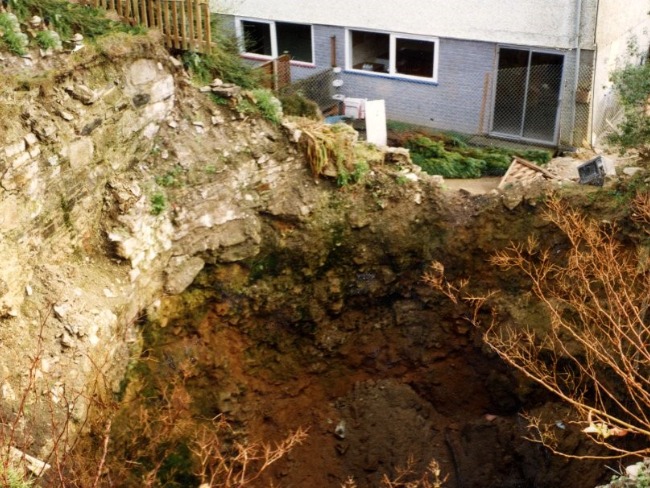
Lessons Learnt from Gunnislake, RGSC Annual Lecture 2019
On Saturday 16th February, Dr. John Grimes presented The Annual Lecture at this year’s Royal Geological Society of Cornwall’s AGM. The lecture was entitled: “Old Gunnislake Mine: The Collapses of 1992, Investigation, Remedial Works and Lessons Learnt”. Dr Grimes summarised the events and causes of the catastrophic mine collapses. Additionally, how we should learn from these events when assessing the stability of land over old mine workings.
The events of 1992 started on the 20th June. A sudden collapse of ground in the rear garden of No.1 Woodland way, Gunnislake, Cornwall. The collapse left a crown hole over 8 metres across and some 10 metres deep. The size of the hole and its proximity to the rear of the dwelling (no more than 2.5 metres away) was alarming! The collapse was centred on Michael’s Shaft; the main engine shaft of the Old Gunnislake Mine. This despite the shaft having been previously capped in the early 1970s.
In the following six months, further mining-related subsidence, collapses and groundwater issues at surface were recorded.
Extensive and detailed ground investigations were carried out across the Old Gunnislake Mine sett. The investigation indicated up to 30 metres of mine waste at Michael’s Shaft. Michael’s Shaft was located within an old stock working, centred on the convergence of two lodes (Great Green Lode and Middle Lode). The investigation and subsequent groundwater monitoring, carried out between 1992 and 1995, identified rapidly varying groundwater levels caused by various collapses and blockages in the adit drainage system. Impeded mine drainage resulted in groundwater levels rising significantly. So much that groundwater rose into the mine waste above rockhead, triggering subsidence and ground water issues. A maximum rise of 13 metres was recorded over a period of three days following extreme wet weather.
Stability analyses led to a contingency plan being drawn up to evacuate a number of houses.
Intricate ground engineering techniques were implemented to secure three shafts (namely Michael’s, William’s and Russell’s), as well as the development of a Pressure Relief Well Scheme, which successfully reduced groundwater level variation. An unnamed shaft on Great Green lode, south of Michael’s Shaft, which was one of the three actively subsiding shafts, was also secured and provided the site for the construction of the upper of two relief wells. The lower relief well was sunk at the junction of King Street and The Orchard. The ground water relief wells were connected via tunnelled relief drainage to South West Water’s existing surface water drainage system in Kings Street.
As part of a risk mitigation scheme, regular monitoring and maintenance of the drainage assets has been successfully implemented.
A number of lessons have been learnt from this project that are pertinent to abandoned mine workings throughout the Southwest. The collapse and blockages of decaying adit drainage systems must be expected. Such blockages can result in significant fluctuation in draining mine/groundwater that can trigger instability. Assessment of stability and indeed treatment of old mine sites must be more extensive than the consideration of capping of old shafts only!

